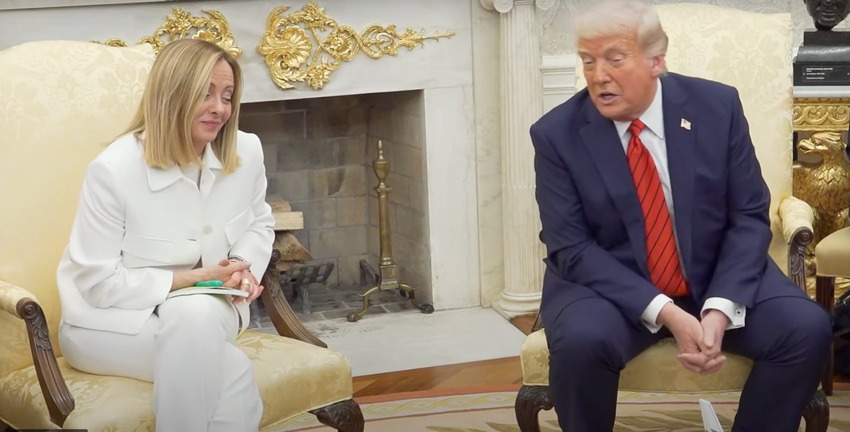Italian Prime Minister Giorgia Meloni’s visit to Washington came at a critical moment, not only for her own political calculus but for Italy’s economic future.
 As President Donald Trump doubles down on his sweeping tariff regime under Executive Order 14257, Meloni steps into the eye of a trade storm that threatens to unravel decades of transatlantic economic cooperation.
As President Donald Trump doubles down on his sweeping tariff regime under Executive Order 14257, Meloni steps into the eye of a trade storm that threatens to unravel decades of transatlantic economic cooperation.
With a €43.9 billion trade surplus with the U.S. at stake, Italy’s industrial heartlands producing everything from prosecco to precision machinery face immediate threats. Meloni’s diplomatic approach, balancing engagement with Trump, was that Italy is shielding its economy from damage. Meanwhile, Europe’s strategic pivot toward China offers potential opportunities, though not without risks.
Italy’s economic reliance on the U.S. market is stark. In 2024, it exported €67.3 billion in goods to the U.S., its second-largest non-EU destination. The tariffs, combining a 10% baseline with an additional 10% on EU products, hit sectors like automobiles, fashion, and agri-food particularly hard.
Confindustria, Italy’s business federation, projects a €7 billion economic hit if the tariffs persist, potentially halving 2025 GDP growth to 0.6%. Small and medium-sized enterprises, the backbone of Italy’s economy, are especially vulnerable. Family-run businesses crafting luxury goods or machinery lack the resources to absorb cost increases or shift supply chains. The auto sector, already reeling from a 25% tariff on cars, faces further strain, though high-end brands like Ferrari may find some resilience among wealthy U.S. buyers. There is a -0.3% GDP drag through 2026, driven by a 1.2% export drop, which underscores the urgency of Meloni’s mission.
Meloni’s Washington visit was a masterclass in pragmatic diplomacy. Her proposal for a zero-for-zero tariff deal aimed to align with EU goals while avoiding escalation. Trump’s decision to pause higher tariffs for 90 days, reducing the EU levy to 10%, offers temporary relief, but the threat of 25% tariffs on steel and cars looms.
The Italian Prime Minister’s approach emphasizing NATO spending commitments and inviting Trump to Italy, seeks to build goodwill, positioning Italy as a reliable U.S. partner. However, this strategy risks straining EU cohesion, as France and Germany advocate a harder line. Italy’s challenge is to secure bilateral concessions without undermining the EU’s collective leverage, a delicate balance in a fractured European landscape.
The U.S. tariffs also push Italy toward a strategic recalibration with China, Europe’s increasingly vital trade partner. Meloni’s 2024 exit from the Belt and Road Initiative, driven by U.S. pressure, has not severed ties with Beijing.
China remains Italy’s third-largest non-EU market, absorbing €18 billion in exports like machinery and fashion in 2024. A new trade pact signed in 2025 aims to boost Italian SME exports to China, targeting high-demand sectors like green technology, where Italy’s expertise in renewable components aligns with China’s net-zero ambitions. China’s own 34% tariffs on U.S. goods, announced in April 2025, could redirect its exports to Europe, creating openings for Italy.
Italy’s ability to weather this trade war hinges on its diplomatic agility and economic adaptability. Meloni’s government faces domestic pressures, with a 140% debt-to-GDP ratio limiting fiscal maneuvering room. The Italian government is pushing for ECB rate cuts and new trade deals with Mexico and India reflect a broader diversification strategy, but these measures require time.
The tariffs’ ripple effects, including potential U.S. disengagement from NATO might add strategic complexity. Italy’s opportunities lie in leveraging Meloni’s Trump connection to secure sector-specific exemptions, particularly for pharmaceuticals and luxury goods, while expanding China ties to offset U.S. market losses. Strengthening the EU single market and investing in green tech could further bolster resilience.
Author: Muhammad Asif Noor – Founder of Friends of BRI Forum, Senior Advisor to Pakistan Research Centre at Hebei Normal University in China, Co-Founder of the Alliance of China-Pakistan Research Centres, and Senior Fellow at the Centre for CPEC Studies at Kashi University in China.
(The opinions expressed in this article are solely those of the author and do not necessarily reflect the views of World Geostrategic Insights).







